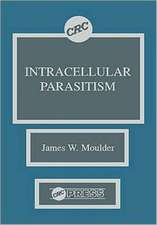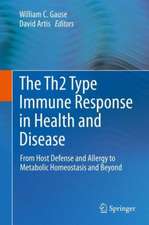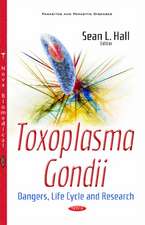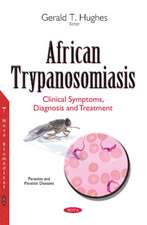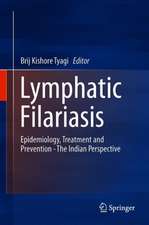Actin Polymerization in Apicomplexan: A Structural, Functional and Evolutionary Analysis
Editat de Avinash Kaleen Limba Engleză Hardback – 26 noi 2019
The book also explores the potential of different actin regulators, namely formin, profilin, actin depolymerization factor (ADF), capping proteins (CPα and CPβ), cyclase-associated protein (CAP) and coronin 13–24 as potential drug targets against malaria. As the chief components of the gliding motor, the actin-regulator proteins are characterized by unique features that make them promising targets for structure-based drug design.
Lastly, the book proposes a mathematical model, based on kinetic data mining, to help understand the most vital regulators for actin polymerization dynamics.
| Toate formatele și edițiile | Preț | Express |
|---|---|---|
| Paperback (1) | 544.38 lei 38-44 zile | |
| Springer Nature Singapore – 26 noi 2020 | 544.38 lei 38-44 zile | |
| Hardback (1) | 637.59 lei 6-8 săpt. | |
| Springer Nature Singapore – 26 noi 2019 | 637.59 lei 6-8 săpt. |
Preț: 637.59 lei
Preț vechi: 750.11 lei
-15% Nou
Puncte Express: 956
Preț estimativ în valută:
122.02€ • 132.49$ • 102.49£
122.02€ • 132.49$ • 102.49£
Carte tipărită la comandă
Livrare economică 22 aprilie-06 mai
Preluare comenzi: 021 569.72.76
Specificații
ISBN-13: 9789811374494
ISBN-10: 981137449X
Pagini: 110
Ilustrații: XI, 101 p. 11 illus. in color.
Dimensiuni: 155 x 235 mm
Greutate: 0.34 kg
Ediția:1st ed. 2019
Editura: Springer Nature Singapore
Colecția Springer
Locul publicării:Singapore, Singapore
ISBN-10: 981137449X
Pagini: 110
Ilustrații: XI, 101 p. 11 illus. in color.
Dimensiuni: 155 x 235 mm
Greutate: 0.34 kg
Ediția:1st ed. 2019
Editura: Springer Nature Singapore
Colecția Springer
Locul publicării:Singapore, Singapore
Cuprins
Chapter 1. Synthesis and Characterization of nano Apicomplexan motility: A cellular perspective particles.- Chapter 2. Introduction: Gliding Motility- The model and the mechanism.- Chapter 3. Actin: The central ubiquitous player in the phenomenon.- Chapter 4. Formin: The multidomain elongator of polymer.- Chapter 5. Profilin: The associates of Formin.- Chapter 6. ADF (Actin Depolymerizing Factor): The breaker of the polymer in homeostasis.- Chapter 7. Cyclase associated protein (CAP): The silent worker.- Chapter 8. Capping Protein (CP): The formin competitor.- Chapter 9. Coronin: An Overview.- Chapter 10. Mathematical Model: A revelation of synergistic cross talks between the actin regulators.- Chapter 11. Evolution: The hallmarks of Gliding motility in apicomplexan.
Notă biografică
Dr. Avinash Kale is a Reader at the School of Chemical Sciences, UM-DAE Centre for Excellence in Basic Sciences, Mumbai, India. His research interests are in the area of integrative structure biology and proteomics (ISBAP). He has more than 16 years of teaching experience in computational biology, biotechnology, molecular modeling and drug design, group theory, spectroscopy, and bioinformatics. He has served as a reviewer for a number of international journals, including the Journal of Biomolecular Structure and Dynamics (USA), and Nature Scientific Reports (USA).
Textul de pe ultima copertă
This book discusses in detail the structural, evolutionary and functional role of actin and its regulatory proteins in gliding motility in apicomplexan organisms, a unique phenomenon found in actin-myosin cytoskeletal elements.
The book also explores the potential of different actin regulators, namely formin, profilin, actin depolymerization factor (ADF), capping proteins (CPα and CPβ), cyclase-associated protein (CAP) and coronin 13–24 as potential drug targets against malaria. As the chief components of the gliding motor, the actin-regulator proteins are characterized by unique features that make them promising targets for structure-based drug design. Lastly, the book proposes a mathematical model, based on kinetic data mining, to help understand the most vital regulators for actin polymerization dynamics.
The book also explores the potential of different actin regulators, namely formin, profilin, actin depolymerization factor (ADF), capping proteins (CPα and CPβ), cyclase-associated protein (CAP) and coronin 13–24 as potential drug targets against malaria. As the chief components of the gliding motor, the actin-regulator proteins are characterized by unique features that make them promising targets for structure-based drug design. Lastly, the book proposes a mathematical model, based on kinetic data mining, to help understand the most vital regulators for actin polymerization dynamics.
Caracteristici
Reviews the mechanism of gliding motility in apicomplexan organisms Discusses the structural, evolutionary, and functional role of actin-regulatory proteins Introduces a mathematical model to help understand the role of actin-regulatory proteins in motility Explores the potential of actin and its regulatory proteins as potential drug targets against apicomplexan organisms





